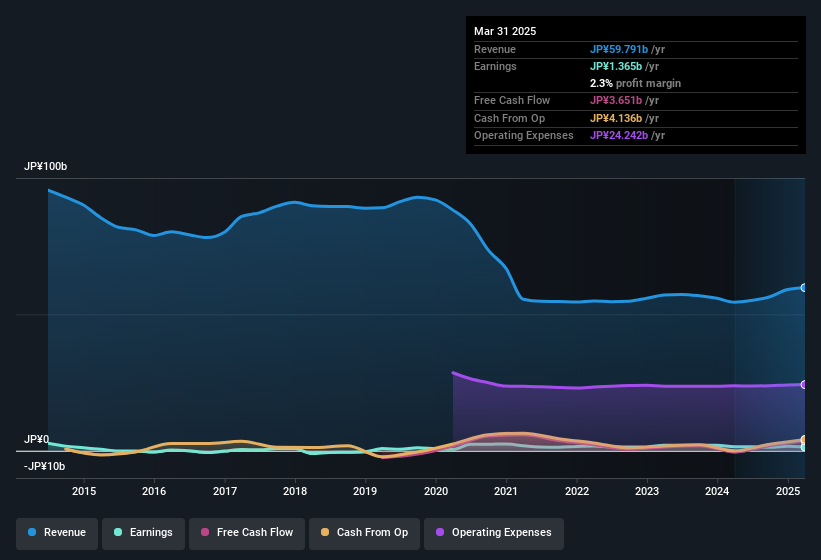
Nac Co., Ltd.'s (TSE:9788) earnings announcement last week didn't impress shareholders. However, our analysis suggests that the soft headline numbers are getting counterbalanced by some positive underlying factors.
Our free stock report includes 3 warning signs investors should be aware of before investing in Nac. Read for free now.
Examining Cashflow Against Nac's Earnings
As finance nerds would already know, the accrual ratio from cashflow is a key measure for assessing how well a company's free cash flow (FCF) matches its profit. To get the accrual ratio we first subtract FCF from profit for a period, and then divide that number by the average operating assets for the period. You could think of the accrual ratio from cashflow as the 'non-FCF profit ratio'.
As a result, a negative accrual ratio is a positive for the company, and a positive accrual ratio is a negative. While it's not a problem to have a positive accrual ratio, indicating a certain level of non-cash profits, a high accrual ratio is arguably a bad thing, because it indicates paper profits are not matched by cash flow. That's because some academic studies have suggested that high accruals ratios tend to lead to lower profit or less profit growth.
For the year to March 2025, Nac had an accrual ratio of -0.11. That indicates that its free cash flow was a fair bit more than its statutory profit. To wit, it produced free cash flow of JP¥3.7b during the period, dwarfing its reported profit of JP¥1.37b. Notably, Nac had negative free cash flow last year, so the JP¥3.7b it produced this year was a welcome improvement. However, that's not all there is to consider. The accrual ratio is reflecting the impact of unusual items on statutory profit, at least in part.
Check out our latest analysis for Nac
Note: we always recommend investors check balance sheet strength. Click here to be taken to our balance sheet analysis of Nac.
The Impact Of Unusual Items On Profit
Nac's profit was reduced by unusual items worth JP¥617m in the last twelve months, and this helped it produce high cash conversion, as reflected by its unusual items. In a scenario where those unusual items included non-cash charges, we'd expect to see a strong accrual ratio, which is exactly what has happened in this case. It's never great to see unusual items costing the company profits, but on the upside, things might improve sooner rather than later. When we analysed the vast majority of listed companies worldwide, we found that significant unusual items are often not repeated. And, after all, that's exactly what the accounting terminology implies. If Nac doesn't see those unusual expenses repeat, then all else being equal we'd expect its profit to increase over the coming year.
Our Take On Nac's Profit Performance
In conclusion, both Nac's accrual ratio and its unusual items suggest that its statutory earnings are probably reasonably conservative. Looking at all these factors, we'd say that Nac's underlying earnings power is at least as good as the statutory numbers would make it seem. So while earnings quality is important, it's equally important to consider the risks facing Nac at this point in time. To help with this, we've discovered 3 warning signs (1 can't be ignored!) that you ought to be aware of before buying any shares in Nac.
After our examination into the nature of Nac's profit, we've come away optimistic for the company. But there is always more to discover if you are capable of focussing your mind on minutiae. Some people consider a high return on equity to be a good sign of a quality business. While it might take a little research on your behalf, you may find this free collection of companies boasting high return on equity, or this list of stocks with significant insider holdings to be useful.
Valuation is complex, but we're here to simplify it.
Discover if Nac might be undervalued or overvalued with our detailed analysis, featuring fair value estimates, potential risks, dividends, insider trades, and its financial condition.
Access Free AnalysisHave feedback on this article? Concerned about the content? Get in touch with us directly. Alternatively, email editorial-team (at) simplywallst.com.
This article by Simply Wall St is general in nature. We provide commentary based on historical data and analyst forecasts only using an unbiased methodology and our articles are not intended to be financial advice. It does not constitute a recommendation to buy or sell any stock, and does not take account of your objectives, or your financial situation. We aim to bring you long-term focused analysis driven by fundamental data. Note that our analysis may not factor in the latest price-sensitive company announcements or qualitative material. Simply Wall St has no position in any stocks mentioned.
About TSE:9788
Nac
Engages in the renting and sale of dust control and cleaning products, and equipment in Japan.
Flawless balance sheet average dividend payer.
Market Insights
Community Narratives



